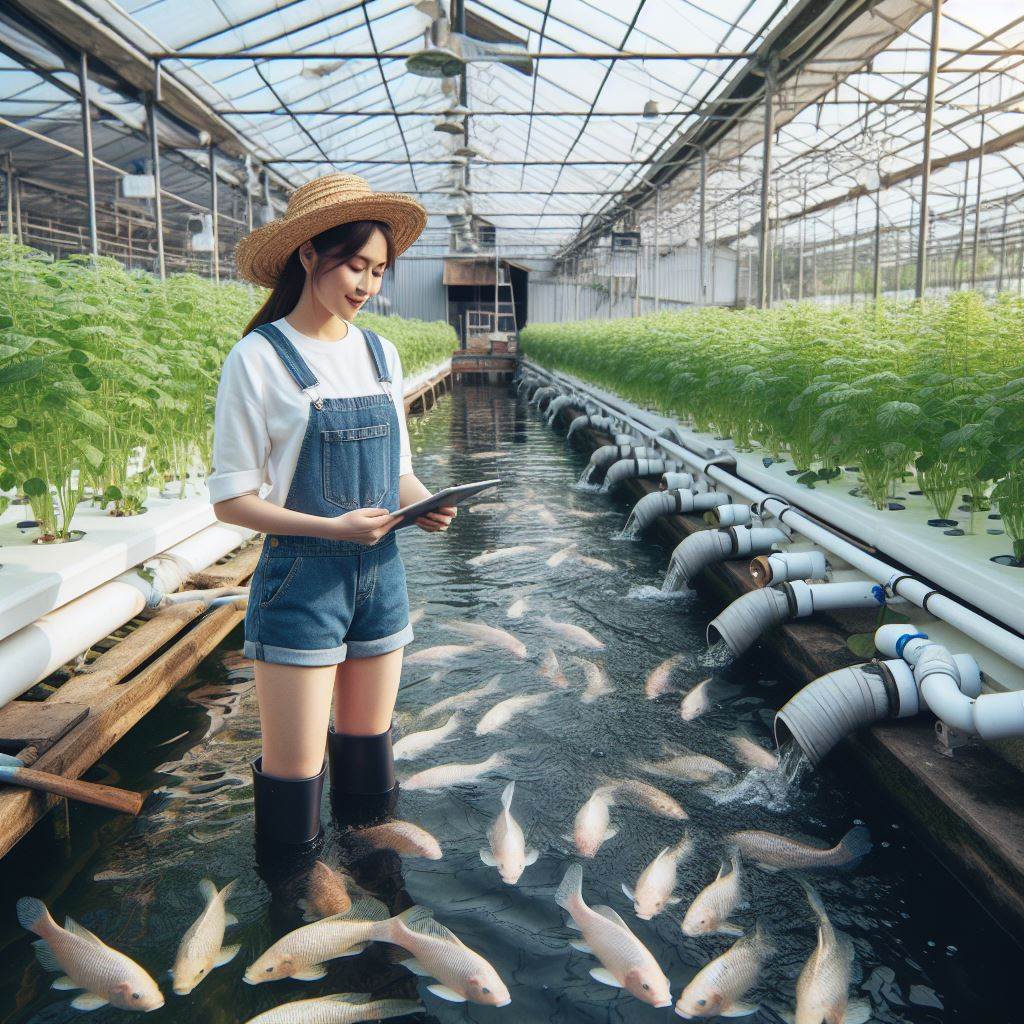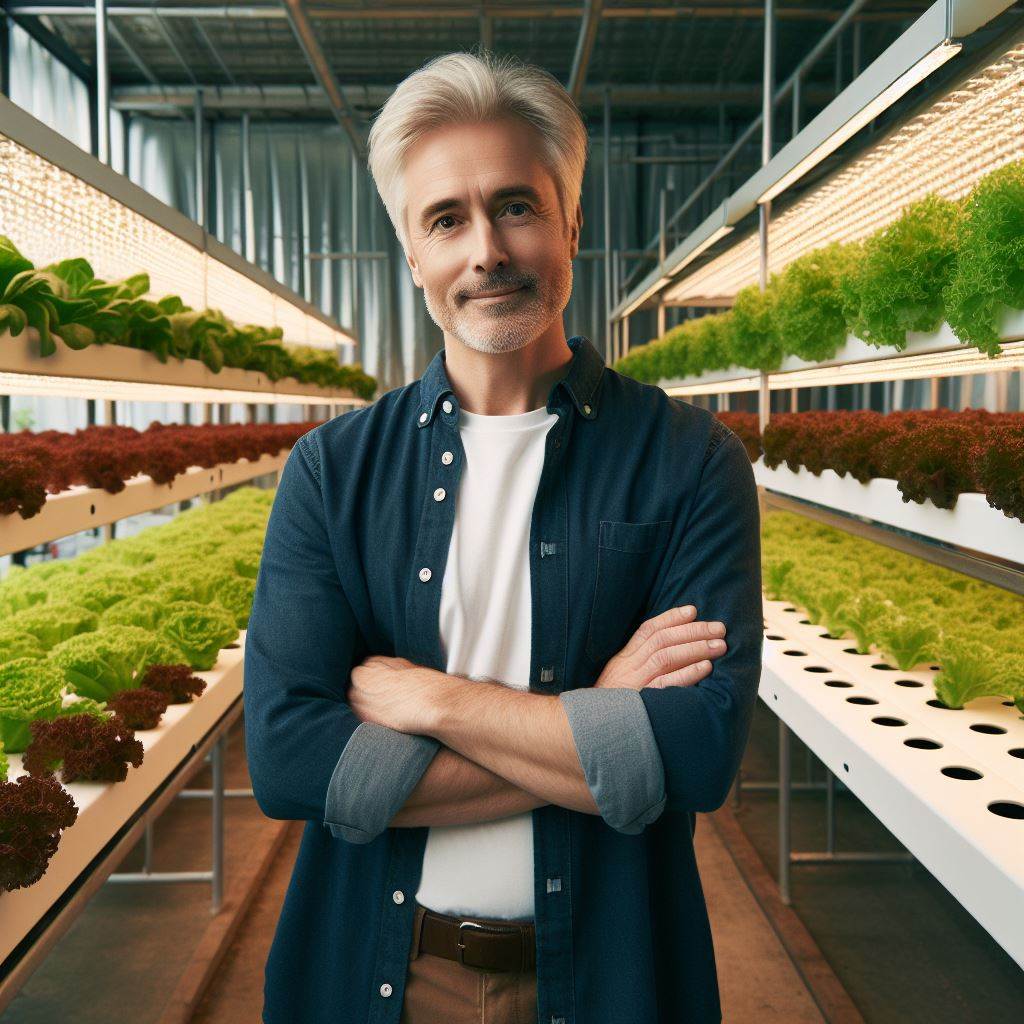Introduction
Aquaponics is a sustainable farming method that combines aquaculture and hydroponics in a symbiotic system.
This innovative technique allows fish and plants to grow together, utilizing each other’s waste products.
The benefits of aquaponics are numerous, including higher crop yields, minimized water usage, and reduced environmental impact.
Aquaponics takes advantage of the natural relationship between fish and plants, creating a harmonious environment where both thrive.
In this system, fish waste provides nutrients for the plants, acting as a natural fertilizer. As the plants absorb these nutrients, they purify the water and create a clean environment for the fish.
This cycle of nutrient exchange ensures optimal growth for both the fish and the plants.
One of the major advantages of aquaponics is its ability to produce higher crop yields compared to traditional farming methods.
This is mainly due to the continuous supply of nutrients provided by the fish waste, resulting in faster and more abundant plant growth.
Additionally, the plants help filter the water, creating a healthier and more stable ecosystem for the fish.
Another benefit of aquaponics is its reduced water usage. Unlike conventional farming, which requires large amounts of water for irrigation, aquaponics recirculates water within the system.
The water is continuously filtered and reused, significantly decreasing the overall water consumption.
This makes aquaponics a more sustainable and environmentally friendly option for food production.
In short, aquaponics offers a sustainable farming solution that allows fish and plants to coexist in harmony.
By utilizing the natural waste products of one organism to benefit the other, this farming method provides numerous benefits, including higher crop yields and reduced water usage.
With its potential to transform agriculture, aquaponics is a promising approach for the future of food production.
Transform Your Agribusiness
Unlock your farm's potential with expert advice tailored to your needs. Get actionable steps that drive real results.
Get StartedThe Basics of Aquaponics
Aquaponics is a sustainable method of farming that combines aquaculture with hydroponics.
Definition and principles
Aquaponics is the cultivation of plants and fish in a symbiotic environment where one benefits the other.
The fish waste provides nutrients for the plants, while the plants filter the water for the fish.
Components of an aquaponics system
Fish tanks
The fish tanks are the home for the fish and are an essential part of the system.
They can be large or small, depending on the scale of the aquaponics system.
Grow beds
The grow beds are where the plants are cultivated.
They can be filled with a medium like gravel or clay pellets to support plant growth.
Water circulation system
The water circulation system ensures that water from the fish tanks flows through the grow beds.
This allows the plants to uptake nutrients and filter out waste products.
Biological filters
Biological filters help break down fish waste and convert it into forms that are usable by the plants.
This process is important for maintaining water quality and ensuring the health of the fish.
Oxygenation system
An oxygenation system is necessary to maintain oxygen levels in the water for the fish.
Proper oxygenation ensures the well-being of the fish and promotes plant growth.
Aquaponics offers numerous benefits over traditional farming methods.
It is highly efficient, as it uses less water and energy compared to conventional agriculture.
It also allows for the production of both fish and plants in the same system, maximizing space utilization.
Aquaponics systems can be built at various scales, from small home setups to large commercial operations.
They can be used to grow a wide range of plants, including herbs, leafy greens, and even fruiting crops.
The choice of fish species in an aquaponics system also varies depending on factors such as water temperature and desired output.
Tilapia and trout are commonly used for their adaptability and ability to withstand fluctuating water conditions.
Other popular choices include catfish, koi, and even ornamental fish like goldfish.
One of the key advantages of aquaponics is the ability to cultivate crops year-round, regardless of weather conditions.
The controlled environment of an aquaponics system allows for optimal plant growth and consistent yields.
In addition, the lack of soil in aquaponics eliminates the need for pesticides and reduces the risk of soil-borne diseases.
Showcase Your Farming Business
Publish your professional farming services profile on our blog for a one-time fee of $200 and reach a dedicated audience of farmers and agribusiness owners.
Publish Your ProfileOverall, aquaponics is a sustainable and efficient method of farming that promotes harmony between fish and plants.
It has the potential to revolutionize food production by providing a year-round, resource-efficient solution for growing fresh produce.
As more people become interested in sustainable agriculture, aquaponics is gaining popularity and evolving as a viable alternative to traditional farming methods.
Read: Hydroponics in the City: Soilless Farming
The Symbiotic Relationship
Explanation of the fish-plant symbiosis
- Fish waste serves as a valuable fertilizer for the plants in an aquaponics system.
- The roots of the plants act as natural filters, removing harmful substances from the water.
Importance of maintaining balance in the system
- Maintaining a proper balance between the fish and plants is crucial for the success of an aquaponics system.
- If there are too few plants, the excess fish waste can accumulate and harm the fish.
- On the other hand, if there are too many plants, they may not receive enough nutrients and suffer.
- It is necessary to strike a balance where the fish produce enough waste to fertilize the plants, but not so much that it becomes toxic for them.
- By maintaining this balance, both the fish and plants thrive in a harmonious coexistence.
- Additionally, this symbiotic relationship reduces the need for synthetic fertilizers, making aquaponics an eco-friendly choice.
- The plants absorb the waste from the fish, purifying the water and providing a clean and healthy environment for the fish to thrive.
- In turn, the fish provide the necessary nutrients for the plants to grow, creating a self-sustaining cycle.
- This relationship is often referred to as a closed-loop system, as the waste produced by one organism is utilized by another.
- The fish and plants work together in perfect harmony, benefiting each other and creating an efficient and sustainable ecosystem.
- Apart from providing food, aquaponics systems also offer educational opportunities, as they demonstrate the principles of symbiosis and ecological balance.
- Children and adults alike can learn about the delicate relationship between living organisms and the importance of maintaining balance in nature.
- Overall, the symbiotic relationship between fish and plants in aquaponics showcases the interconnectedness of ecosystems and the potential for sustainable agriculture.
- It represents a viable solution for reducing water consumption, minimizing waste, and producing fresh and healthy food.
- As more people recognize the benefits of aquaponics, this innovative farming method has the potential to revolutionize the way we grow food.
Read: Urban Livestock: Raising Chickens & More
Choosing the Right Fish
Popular fish species used in aquaponics
When it comes to choosing the right fish for your aquaponics system, there are several popular species that work well:
Tilapia
Tilapia is one of the most common fish species used in aquaponics. They are hardy, fast-growing, and can tolerate a wide range of water temperatures.
Trout
Trout is another popular choice, especially in colder climates. They require cooler water temperatures and thrive in well-oxygenated systems.
Catfish
Catfish are known for their robustness and ability to withstand poor water conditions. They are also great for consuming excess nutrients in the system.
Factors to consider when selecting fish
When deciding which fish species to include in your aquaponics system, you should consider the following factors:
Water temperature requirements
Different fish species have different temperature preferences. Ensure that the fish you choose can thrive within the temperature range of your system.
Feeding habits and nutrient needs
Some fish species are herbivorous, while others are carnivorous or omnivorous. Make sure the fish you select match the feeding habits and nutrient requirements of the plants you want to grow.
Fish compatibility
Not all fish species are compatible with each other. Some may exhibit aggressive behavior towards others, leading to stress and potential harm.
Research the compatibility of different fish species before making your selection.
In essence, choosing the right fish for your aquaponics system is essential for a successful and harmonious environment.
Consider popular species like tilapia, trout, and catfish, while also taking into account factors such as water temperature requirements, feeding habits, and fish compatibility.
Read: Balcony Farms: Grow Food in Small Spaces
Selecting Aquaponic Plants
Aquaponics is a sustainable system that combines fish farming (aquaculture) with plant cultivation (hydroponics).
In this system, fish waste provides nutrients for the plants to grow, while the plants filter and clean the water for the fish.
One of the key aspects of successful aquaponics is selecting the right plants to grow.
Types of plants suitable for aquaponics
Aquaponics is particularly well-suited for growing certain types of plants, including leafy greens, herbs, and fruit-bearing plants.
Leafy greens (lettuce, kale, spinach)
Leafy greens are some of the most popular plants to grow in aquaponics systems. They have shallow root systems and can absorb nutrients efficiently from the water.
Herbs (basil, mint, parsley)
Herbs also thrive in aquaponics setups. They don’t require a lot of space and can add flavor to your meals while providing a visually pleasing aesthetic.
Fruit-bearing plants (tomatoes, peppers, strawberries)
Although fruit-bearing plants require more space and nutritional needs, they can be successfully grown in aquaponics.
The nutrient-rich water helps them produce flavorful and abundant fruits.
Factors to consider when choosing plants
When selecting plants for your aquaponics system, there are several factors to take into account.
Water pH and nutrient requirements
Different plants have varying pH and nutrient requirements. It’s essential to choose plants that can thrive in the water conditions provided by your system.
Conduct regular water testing to maintain optimal pH levels for your plants.
Growth rate and space requirements
Consider the growth rate and space requirements of the plants. Some plants grow quickly and may outcompete others for space and nutrients.
Plan accordingly and provide adequate space for each plant to grow.
Sunlight exposure
Plants need sufficient sunlight to perform photosynthesis and grow.
Ensure that your aquaponics setup receives adequate sunlight or supplement with artificial lighting if necessary.
In general, selecting the right plants is crucial for a successful aquaponics system. Leafy greens, herbs, and fruit-bearing plants are suitable choices.
Consider factors such as water pH, nutrient requirements, growth rate, space requirements, and sunlight exposure when choosing plants for your aquaponics setup.
By carefully selecting plants, you can have a harmonious and thriving aquaponics system.
Read: Sustainable Fertilizers: A Carbon Fix

Balancing the System
Monitoring and maintaining water quality
pH levels
Maintaining the proper pH levels is crucial for the overall health of both fish and plants in an aquaponics system.
pH levels should ideally be maintained between 6.8 and 7.2.
Ammonia and nitrite levels
Regularly monitoring ammonia and nitrite levels is important to ensure the well-being of the fish.
Ammonia levels should be kept below 0.5 ppm, while nitrite levels should be maintained below 1 ppm.
Showcase Your Farming Business
Publish your professional farming services profile on our blog for a one-time fee of $200 and reach a dedicated audience of farmers and agribusiness owners.
Publish Your ProfileDissolved oxygen levels
Maintaining adequate dissolved oxygen levels is essential for the survival of fish and plants.
Proper aeration and water circulation techniques should be implemented to ensure the levels stay between 4 and 7 ppm.
Feeding the fish and plants properly
Determining appropriate fish feeding quantities
Feeding fish the right quantities is crucial for their growth and survival. It is important to prevent overfeeding, which can lead to poor water quality.
Feed the fish an amount they can consume within 5 minutes.
Nutrient supplementation for plants
While fish waste provides some nutrients, additional supplementation may be necessary for optimal plant growth.
Adding organic fertilizers or supplements like iron or potassium can help maintain nutrient levels in the aquaponics system.
By closely monitoring and maintaining water quality, you can ensure the success of your aquaponics system.
pH levels should be regularly checked to maintain a healthy environment for both the fish and plants.
Additionally, ammonia and nitrite levels should be monitored to prevent fish stress and potential toxicity.
Adequate levels of dissolved oxygen are essential for the survival of fish and plants, so proper aeration and water circulation should be maintained.
Feeding the fish the appropriate amounts is crucial to prevent overfeeding, which can lead to poor water quality.
It is recommended to only feed the fish an amount that they can consume within 5 minutes.
This helps ensure that the fish are getting the necessary nutrients without excess waste.
Additionally, supplementing the plants with organic fertilizers or specific nutrients like iron or potassium can help promote optimal growth.
By following these guidelines and monitoring the system regularly, you can maintain a balanced and thriving aquaponics system.
Remember that each component of the system relies on the other, so maintaining harmony is essential for overall success.
Troubleshooting Common Issues
Algae growth control
- Increase shade by adding a cover or planting floating plants to block sunlight.
- Reduce nutrient levels by adjusting fish feeding and monitoring water quality.
- Install a UV sterilizer or use algaecides as a last resort for persistent algae problems.
Fish illness and disease management
- Regularly monitor water parameters to ensure optimal conditions for fish health.
- Quarantine new fish before introducing them to the aquaponics system.
- Treat sick fish promptly using appropriate medications or natural remedies.
- Remove dead fish immediately to prevent the spread of diseases.
Nutrient deficiencies in plants
- Test the water for nutrient levels regularly to identify deficiencies.
- Adjust the fish feeding or use supplemental nutrients to meet plant requirements.
- Monitor pH levels and adjust, if necessary, as improper pH can affect nutrient uptake.
- Consider adding beneficial microorganisms or organic matter to enhance nutrient availability.
Overcrowding and system scaling considerations
- Monitor fish growth and ensure they have enough space to swim comfortably.
- Avoid overstocking the system and maintain a balanced fish-to-plant ratio.
- Regularly check and clean filters to prevent clogs and ensure efficient water flow.
- Consider expanding the system or upgrading components if overcrowding becomes an issue.
Troubleshooting common issues in aquaponics is crucial for maintaining a thriving system.
Algae growth is a frequent problem that can be controlled by increasing shade and reducing nutrient levels.
Fish illness and disease management require regular monitoring of water parameters, quarantining new fish, and prompt treatment of sick fish.
Nutrient deficiencies in plants can be addressed by testing water, adjusting feeding, monitoring pH, and adding beneficial microorganisms.
Overcrowding and system scaling considerations involve monitoring fish growth, maintaining a balanced ratio, checking and cleaning filters, and considering system expansion if necessary.
By addressing these common challenges, aquaponics enthusiasts can ensure the harmonious relationship between fish and plants.
Conclusion
Aquaponics offers numerous benefits that make it an innovative and sustainable method of cultivation.
By combining fish and plants in a symbiotic relationship, aquaponics not only provides a fresh source of food but also promotes environmental conservation.
Through the efficient use of water and nutrients, aquaponics reduces water waste and reliance on synthetic fertilizers.
Additionally, this system eliminates the need for harmful pesticides, resulting in cleaner and healthier produce.
Furthermore, aquaponics allows for year-round cultivation regardless of weather conditions, providing a consistent food supply.
This feature is particularly valuable in regions where agriculture is limited due to extreme climates.
For readers who are interested in exploring alternative methods of food production, aquaponics presents an exciting opportunity.
Its easy setup and maintenance, along with its potential for scalability, make it accessible to both beginners and experienced cultivators.
As aquaponics continues to gain popularity, we can expect future advancements in the field.
These may include improved fish feed formulations, advanced monitoring systems for optimized growth, and the integration of renewable energy sources.
Aquaponics offers a sustainable and efficient solution to traditional farming practices.
Its benefits go beyond just providing food, as it contributes to water conservation, reduces environmental impact, and promotes self-sufficiency.
We encourage readers to give aquaponics a try and be a part of this agricultural revolution.




